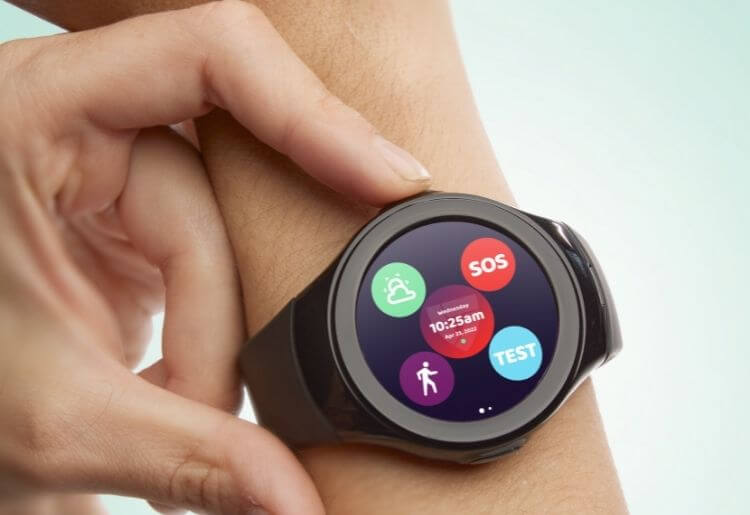While no device can replace the advice of a qualified medical professional and a comprehensive safety plan, advances in wearable technology make it easier to keep track and stay on top of certain medical conditions and get emergency help more quickly.
Medical alert companies are starting to adopt smartwatch technology, allowing for more effective safety monitoring for seniors and people who have conditions that require daily management, like diabetics.
One example of a company doing just that is Medical Guardian, a leader in the medical-alert industry. They’ve developed a new simple-to-use device with smartwatch technology that comes with a one-touch alert button, voice-to-text communications and a step counter. It’s ideal for anyone who wants to live independently while ensuring support and safety.
1. Sending for help when every second is critical
One of the greatest concerns for seniors - and their caregivers - is the possibility of a fall when no one is around to help. While many safety alert systems require users to press a button if they take a tumble, there are plenty of smartwatches that come with a drop sensor, which automatically sounds an alarm if a fall is detected. If the user doesn’t turn off the alarm manually, the device alerts emergency services and the wearer’s emergency contacts.
Fall detection should be a priority for anyone who has problems with mobility, or a medical condition that could result in a collapse, such as narcolepsy or low blood pressure. In your search for a smartwatch, be sure to research the best medical alert systems, so that you can find the right device with the features you need.
2. Monitoring heart rate
The normal resting heart rate for adults is between 60 and 100 beats per minute. If your heart rate repeatedly falls outside this range while at rest, you may have a medical condition. With advanced pulse monitoring features, smartwatches can pick up on abnormal heart rate patterns and alert you if your pulse falls outside of the healthy range.
A New York Times article published in 2021 detailed how one smartwatch wearer used her wearable to check her heart rate, found it to be dangerously low, and was rushed to the hospital where doctors implanted a pacemaker.
3. Getting help quickly without using a phone
When an accident or emergency occurs, it is sometimes impossible to get to the phone, let alone unlock it and make a call for help. Senior citizens may also be intimated by the many apps, buttons, and tap-and-swipe actions that come standard with smartphones these days.
Some medical alert companies have taken steps to make calling for help phone-free, much easier. They’ve combined the most useful features of smartwatches with lifesaving medical alert systems, allowing the device’s wearer to call for help with the press of a single button.
Some smartwatch models even offer separate cell service for the wearable, so there’s no need to be within Bluetooth range to make a call. There are even models that combine the efficacy of medical bracelets with cutting-edge technology, offering quick access to medical information for first responders. This allows them to make critical, life-saving decisions as quickly as possible.
4. Tracking your heart’s electrical rhythms
In addition to pulse monitoring, several wearable devices have built-in technology to collect electrocardiogram (also known as ECG or EKG) data. An ECG records the electrical signals of the heart to collect data on its rhythm and the strength of its electrical impulses. Data from ECGs is crucial in diagnosing many cardiac conditions.
In “Diagnostic Accuracy of Smartwatches for the Detection of Cardiac Arrhythmia,” a 2021 study cited by the National Institute of Health, researchers found that the accuracy of smartwatches in detecting abnormal heart rhythms was close to 100%. While full ECGs are performed in doctors’ offices and hospitals using several electrodes and wires, certain smartwatches—such as newer-model Apple Watches—can record ECG data, providing valuable information to physicians as they make crucial treatment decisions. Access to these ECGs can also help people with known heart conditions monitor their health from anywhere.
5. Reminding you to stay active
Physical activity is key to maintaining a healthy lifestyle, dealing with mental health issues, and keeping your heart and lungs strong. Smartwatches remind you to stand up, move around, and reach your exercise goals.
A 2019 study from the National Library of Medicine found that the activity trackers in most wearables have many benefits for their wearers’ physical activity. New technology can even provide other useful information such as your walking steadiness, which assesses your balance, strength, and gait.
Some medical alert companies are taking this technology a step further, developing ways to seamlessly gather and share information on activity trends, with the end goal of helping patients find more ways to effectively improve their overall health.
6. Improving your sleep
The quality and quantity of your sleep can make a huge difference to your health and quality of life. Wearing a smartwatch helps you keep track of your sleep patterns: duration, continuity, and quality. While these features probably won’t replace more advanced sleep studies conducted by medical professionals, data from advanced smartwatches can provide key information on blood oxygen levels, sleeping heart rates, and nighttime respiratory rates.
In an article published by Johns Hopkins Medicine, Alan Schwartz, M.D., Director of the Sleep Disorders Center at Johns Hopkins Bayview Medical Center, pointed out that most smartwatch sleep trackers don’t actually measure sleep. Rather, they track rest or inactivity periods. 
7. Monitoring blood oxygen levels
Your blood oxygen level is the percentage of oxygen that your red blood cells carry from your lungs to the rest of your body. They’re a good indication of how well your body absorbs oxygen and how efficiently your lungs are working. A reading of 95-100% is considered normal for a healthy adult. Lower readings may be a sign of heart, lung, or circulatory issues.
Usually, blood oxygen levels are measured with a monitor that fits over your finger. With wearable technology, they can be measured on your wrist. Blood oxygen tracking is now standard in many smartwatches—Fitbit, Garmin, Mobvoi, Samsung, and Apple.
8. Managing your stress
Humans have evolved to function well with short bursts of stress, helping us avoid danger, boost energy, and perform better in challenging or risky situations. Repeated bouts of stress, however, can cause many different physical problems, like digestive issues, panic attacks, depression, and more.
Several smartwatch brands offer useful ways to track and manage stress. reminders to breathe deeply and stress management calculators that score your stress management on daily basis. With this information, you can make positive changes to reduce stress and improve your health and well-being.
9. Connecting your watch to health measurements you need
As wearable technology continues to improve, you have more and more options for features to help you meet your individual health goals. For diabetics and pre-diabetics, some smartwatches can even connect to blood sugar monitoring systems giving glucose alerts at the most critical times.
Specialized smartwatches can take blood pressure readings directly at the wrist, while others can track skin temperature throughout the day, alerting users to possible infection, stress, and other potential health risks.
All of these measurements can be stored in your phone for easy access when consulting with your doctor.
Smartwatch technology can be your health companion
With the ability to monitor health and safety and call for help if needed, smartwatches are becoming more important tools to not only keep us free of harm but to improve our overall well-being. If you’re in the market for a smartwatch or wearable alert system, be sure to look for the features that are most important to you.
While these devices cannot replace professional medical advice or a detailed safety plan, they are an invaluable—and sometimes life-saving—tool.
